Employee Motivation and Retention: A Human Resource Management Report
VerifiedAdded on 2022/08/14
|10
|2549
|12
Report
AI Summary
This report delves into the critical aspects of employee motivation and retention within a retail organization, using a case study of an employee named Mr. Simon who experienced demotivation due to lack of career progression and recognition. The report explores the significance of employee motivation in achieving organizational goals and maximizing wealth. It examines various motivational theories, including Maslow's Hierarchy of Needs, Herzberg's Motivation-Hygiene Theory, and McGregor's Theory X and Y, to understand the factors influencing employee satisfaction and dissatisfaction. The analysis highlights the role of a team leader in fostering a motivating work environment and offers recommendations for retaining valuable employees, such as providing opportunities for growth, offering fair compensation, and recognizing achievements. The report emphasizes the importance of addressing employee needs and creating a positive work environment to enhance productivity and reduce employee turnover.
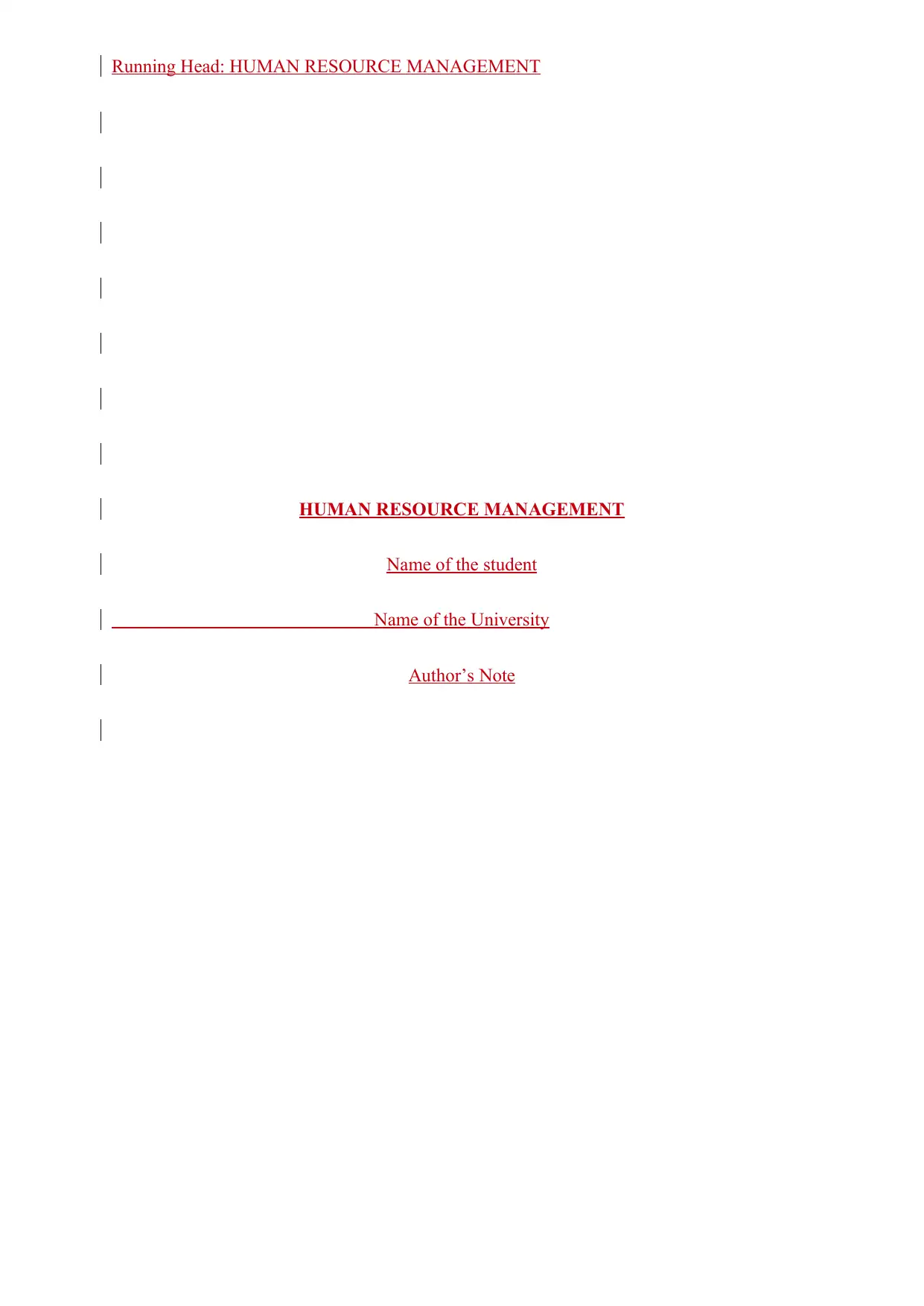
Running Head: HUMAN RESOURCE MANAGEMENT
HUMAN RESOURCE MANAGEMENT
Name of the student
Name of the University
Author’s Note
HUMAN RESOURCE MANAGEMENT
Name of the student
Name of the University
Author’s Note
Paraphrase This Document
Need a fresh take? Get an instant paraphrase of this document with our AI Paraphraser
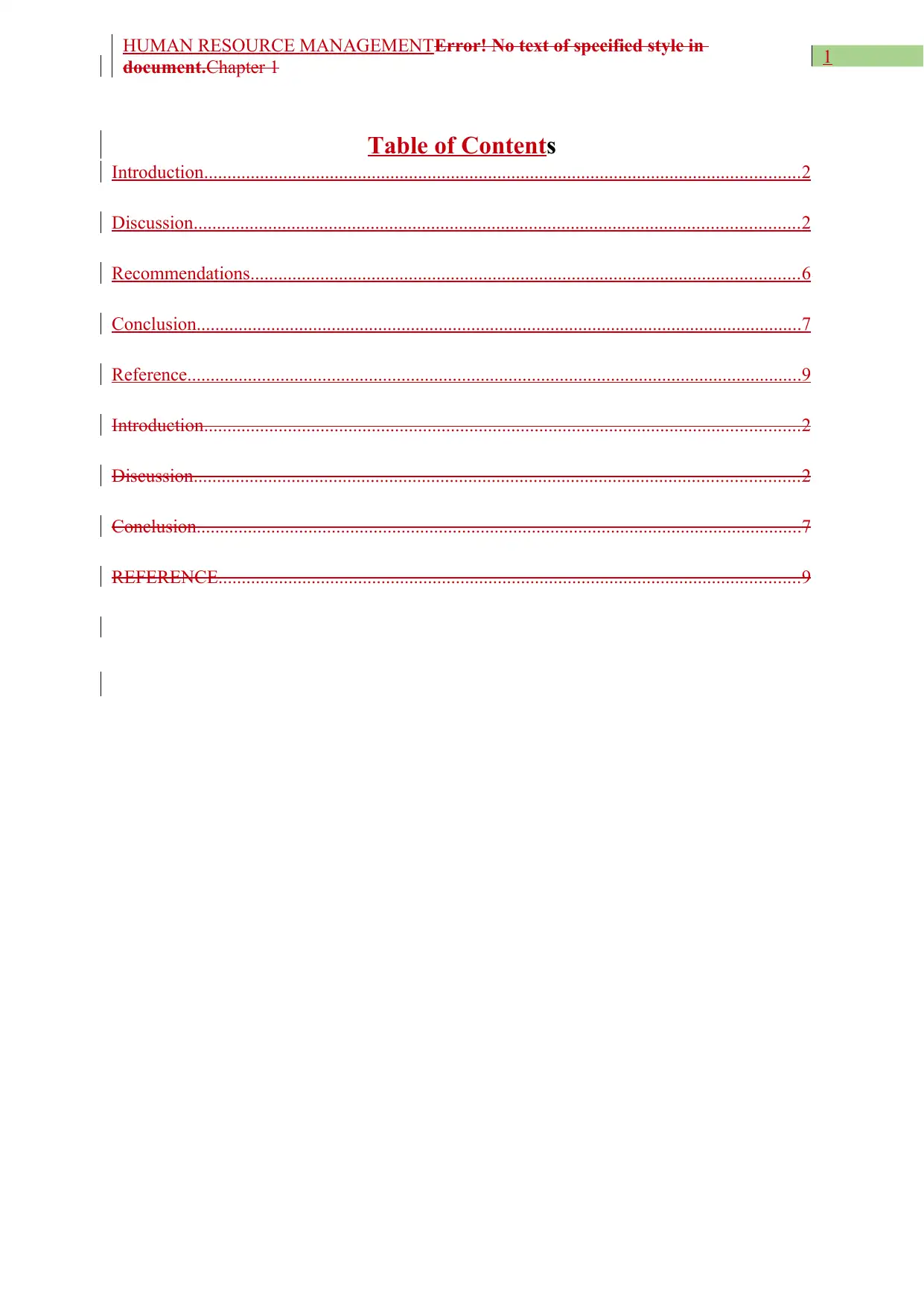
1
HUMAN RESOURCE MANAGEMENTError! No text of specified style in
document.Chapter 1
Table of Contents
Introduction................................................................................................................................2
Discussion..................................................................................................................................2
Recommendations......................................................................................................................6
Conclusion..................................................................................................................................7
Reference....................................................................................................................................9
Introduction................................................................................................................................2
Discussion..................................................................................................................................2
Conclusion..................................................................................................................................7
REFERENCE.............................................................................................................................9
HUMAN RESOURCE MANAGEMENTError! No text of specified style in
document.Chapter 1
Table of Contents
Introduction................................................................................................................................2
Discussion..................................................................................................................................2
Recommendations......................................................................................................................6
Conclusion..................................................................................................................................7
Reference....................................................................................................................................9
Introduction................................................................................................................................2
Discussion..................................................................................................................................2
Conclusion..................................................................................................................................7
REFERENCE.............................................................................................................................9
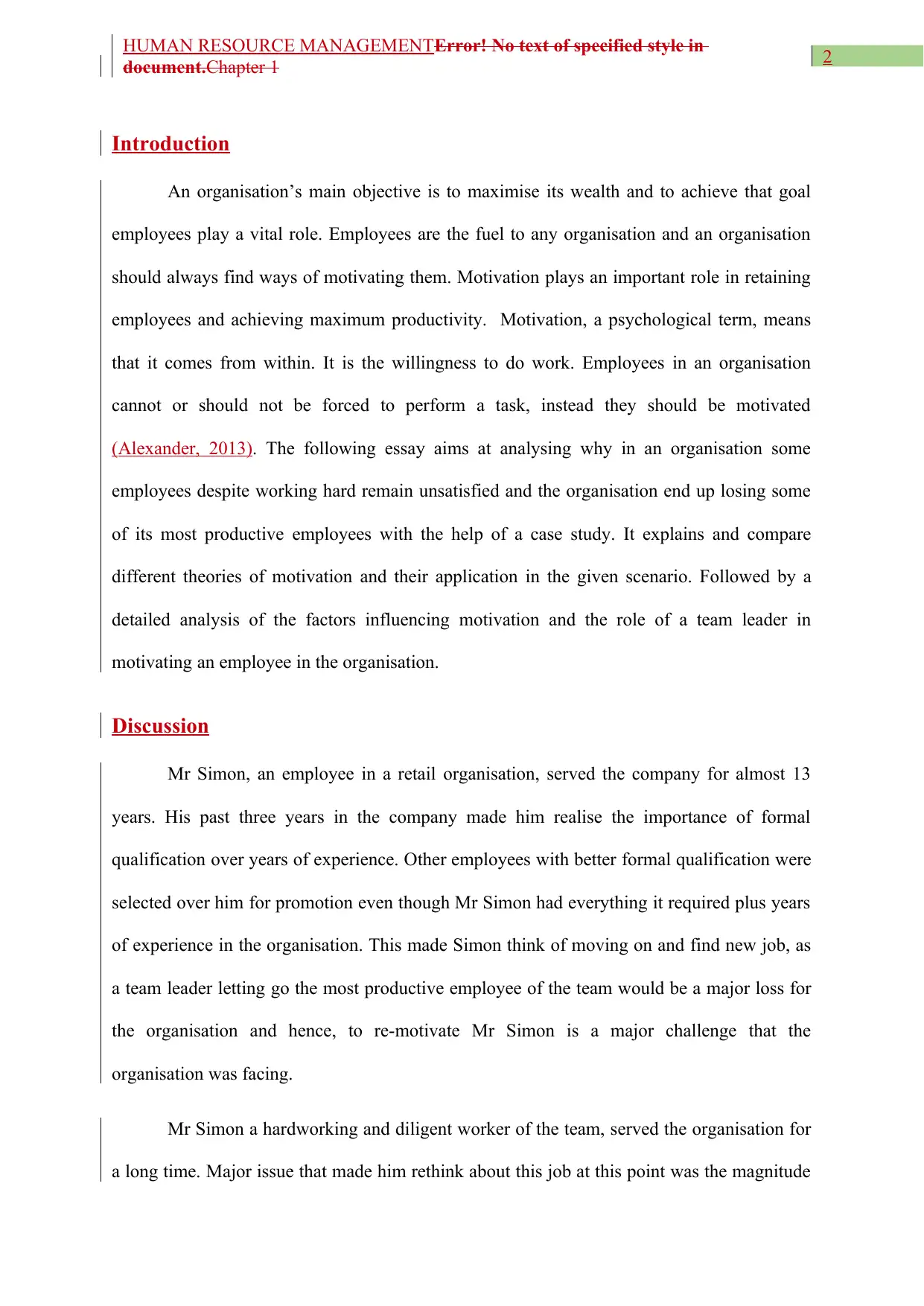
2
HUMAN RESOURCE MANAGEMENTError! No text of specified style in
document.Chapter 1
Introduction
An organisation’s main objective is to maximise its wealth and to achieve that goal
employees play a vital role. Employees are the fuel to any organisation and an organisation
should always find ways of motivating them. Motivation plays an important role in retaining
employees and achieving maximum productivity. Motivation, a psychological term, means
that it comes from within. It is the willingness to do work. Employees in an organisation
cannot or should not be forced to perform a task, instead they should be motivated
(Alexander, 2013). The following essay aims at analysing why in an organisation some
employees despite working hard remain unsatisfied and the organisation end up losing some
of its most productive employees with the help of a case study. It explains and compare
different theories of motivation and their application in the given scenario. Followed by a
detailed analysis of the factors influencing motivation and the role of a team leader in
motivating an employee in the organisation.
Discussion
Mr Simon, an employee in a retail organisation, served the company for almost 13
years. His past three years in the company made him realise the importance of formal
qualification over years of experience. Other employees with better formal qualification were
selected over him for promotion even though Mr Simon had everything it required plus years
of experience in the organisation. This made Simon think of moving on and find new job, as
a team leader letting go the most productive employee of the team would be a major loss for
the organisation and hence, to re-motivate Mr Simon is a major challenge that the
organisation was facing.
Mr Simon a hardworking and diligent worker of the team, served the organisation for
a long time. Major issue that made him rethink about this job at this point was the magnitude
HUMAN RESOURCE MANAGEMENTError! No text of specified style in
document.Chapter 1
Introduction
An organisation’s main objective is to maximise its wealth and to achieve that goal
employees play a vital role. Employees are the fuel to any organisation and an organisation
should always find ways of motivating them. Motivation plays an important role in retaining
employees and achieving maximum productivity. Motivation, a psychological term, means
that it comes from within. It is the willingness to do work. Employees in an organisation
cannot or should not be forced to perform a task, instead they should be motivated
(Alexander, 2013). The following essay aims at analysing why in an organisation some
employees despite working hard remain unsatisfied and the organisation end up losing some
of its most productive employees with the help of a case study. It explains and compare
different theories of motivation and their application in the given scenario. Followed by a
detailed analysis of the factors influencing motivation and the role of a team leader in
motivating an employee in the organisation.
Discussion
Mr Simon, an employee in a retail organisation, served the company for almost 13
years. His past three years in the company made him realise the importance of formal
qualification over years of experience. Other employees with better formal qualification were
selected over him for promotion even though Mr Simon had everything it required plus years
of experience in the organisation. This made Simon think of moving on and find new job, as
a team leader letting go the most productive employee of the team would be a major loss for
the organisation and hence, to re-motivate Mr Simon is a major challenge that the
organisation was facing.
Mr Simon a hardworking and diligent worker of the team, served the organisation for
a long time. Major issue that made him rethink about this job at this point was the magnitude
⊘ This is a preview!⊘
Do you want full access?
Subscribe today to unlock all pages.

Trusted by 1+ million students worldwide
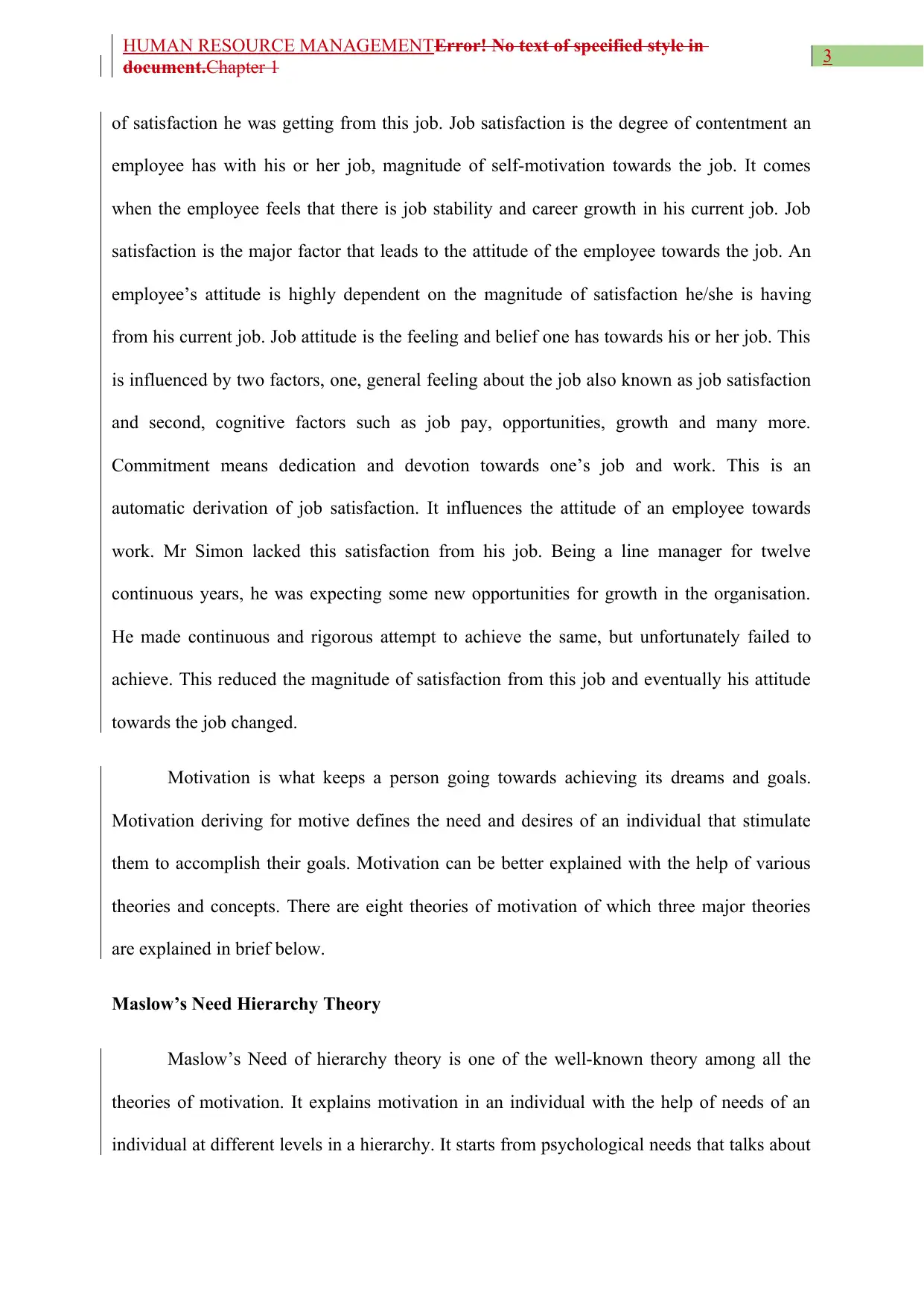
3
HUMAN RESOURCE MANAGEMENTError! No text of specified style in
document.Chapter 1
of satisfaction he was getting from this job. Job satisfaction is the degree of contentment an
employee has with his or her job, magnitude of self-motivation towards the job. It comes
when the employee feels that there is job stability and career growth in his current job. Job
satisfaction is the major factor that leads to the attitude of the employee towards the job. An
employee’s attitude is highly dependent on the magnitude of satisfaction he/she is having
from his current job. Job attitude is the feeling and belief one has towards his or her job. This
is influenced by two factors, one, general feeling about the job also known as job satisfaction
and second, cognitive factors such as job pay, opportunities, growth and many more.
Commitment means dedication and devotion towards one’s job and work. This is an
automatic derivation of job satisfaction. It influences the attitude of an employee towards
work. Mr Simon lacked this satisfaction from his job. Being a line manager for twelve
continuous years, he was expecting some new opportunities for growth in the organisation.
He made continuous and rigorous attempt to achieve the same, but unfortunately failed to
achieve. This reduced the magnitude of satisfaction from this job and eventually his attitude
towards the job changed.
Motivation is what keeps a person going towards achieving its dreams and goals.
Motivation deriving for motive defines the need and desires of an individual that stimulate
them to accomplish their goals. Motivation can be better explained with the help of various
theories and concepts. There are eight theories of motivation of which three major theories
are explained in brief below.
Maslow’s Need Hierarchy Theory
Maslow’s Need of hierarchy theory is one of the well-known theory among all the
theories of motivation. It explains motivation in an individual with the help of needs of an
individual at different levels in a hierarchy. It starts from psychological needs that talks about
HUMAN RESOURCE MANAGEMENTError! No text of specified style in
document.Chapter 1
of satisfaction he was getting from this job. Job satisfaction is the degree of contentment an
employee has with his or her job, magnitude of self-motivation towards the job. It comes
when the employee feels that there is job stability and career growth in his current job. Job
satisfaction is the major factor that leads to the attitude of the employee towards the job. An
employee’s attitude is highly dependent on the magnitude of satisfaction he/she is having
from his current job. Job attitude is the feeling and belief one has towards his or her job. This
is influenced by two factors, one, general feeling about the job also known as job satisfaction
and second, cognitive factors such as job pay, opportunities, growth and many more.
Commitment means dedication and devotion towards one’s job and work. This is an
automatic derivation of job satisfaction. It influences the attitude of an employee towards
work. Mr Simon lacked this satisfaction from his job. Being a line manager for twelve
continuous years, he was expecting some new opportunities for growth in the organisation.
He made continuous and rigorous attempt to achieve the same, but unfortunately failed to
achieve. This reduced the magnitude of satisfaction from this job and eventually his attitude
towards the job changed.
Motivation is what keeps a person going towards achieving its dreams and goals.
Motivation deriving for motive defines the need and desires of an individual that stimulate
them to accomplish their goals. Motivation can be better explained with the help of various
theories and concepts. There are eight theories of motivation of which three major theories
are explained in brief below.
Maslow’s Need Hierarchy Theory
Maslow’s Need of hierarchy theory is one of the well-known theory among all the
theories of motivation. It explains motivation in an individual with the help of needs of an
individual at different levels in a hierarchy. It starts from psychological needs that talks about
Paraphrase This Document
Need a fresh take? Get an instant paraphrase of this document with our AI Paraphraser
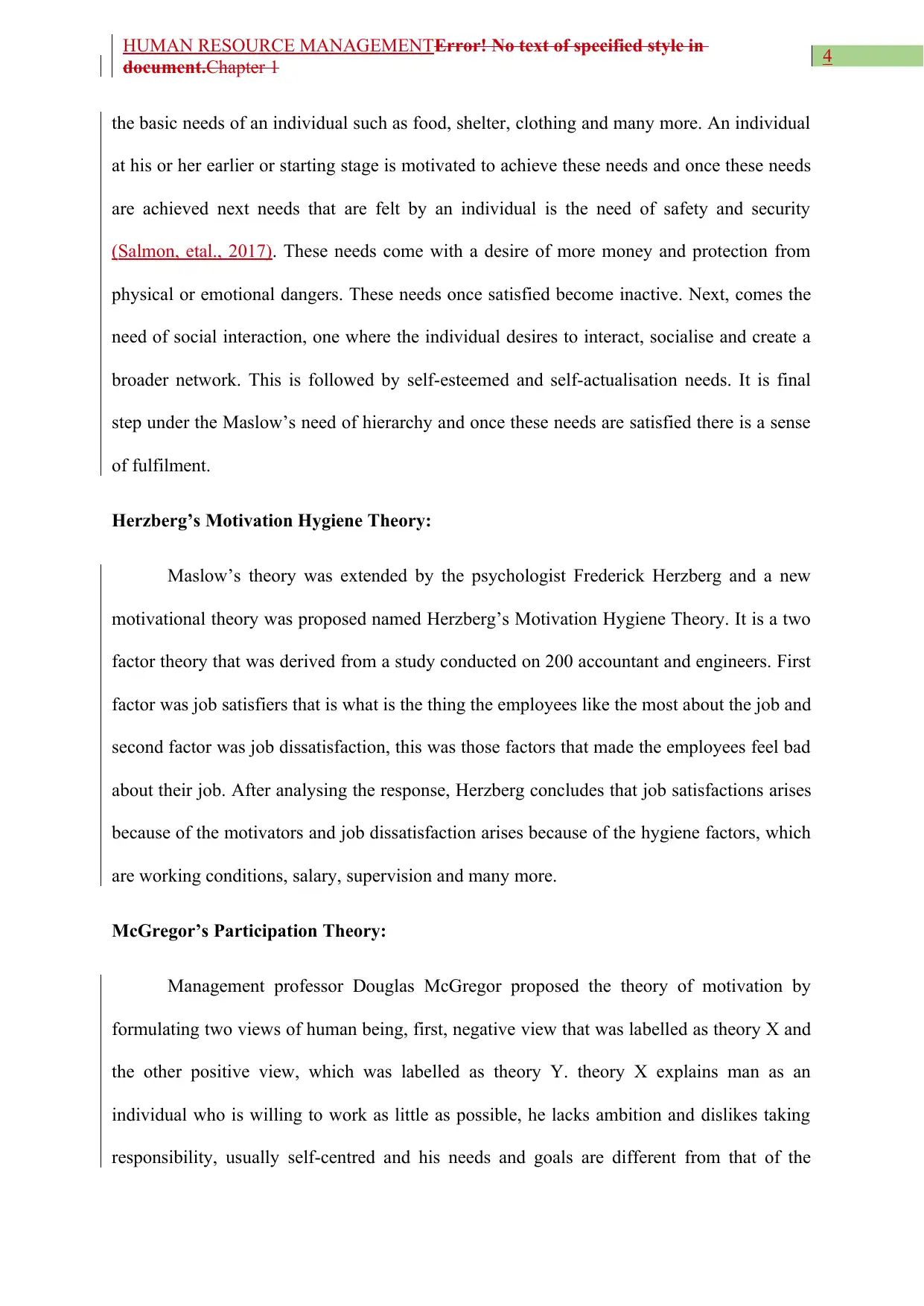
4
HUMAN RESOURCE MANAGEMENTError! No text of specified style in
document.Chapter 1
the basic needs of an individual such as food, shelter, clothing and many more. An individual
at his or her earlier or starting stage is motivated to achieve these needs and once these needs
are achieved next needs that are felt by an individual is the need of safety and security
(Salmon, etal., 2017). These needs come with a desire of more money and protection from
physical or emotional dangers. These needs once satisfied become inactive. Next, comes the
need of social interaction, one where the individual desires to interact, socialise and create a
broader network. This is followed by self-esteemed and self-actualisation needs. It is final
step under the Maslow’s need of hierarchy and once these needs are satisfied there is a sense
of fulfilment.
Herzberg’s Motivation Hygiene Theory:
Maslow’s theory was extended by the psychologist Frederick Herzberg and a new
motivational theory was proposed named Herzberg’s Motivation Hygiene Theory. It is a two
factor theory that was derived from a study conducted on 200 accountant and engineers. First
factor was job satisfiers that is what is the thing the employees like the most about the job and
second factor was job dissatisfaction, this was those factors that made the employees feel bad
about their job. After analysing the response, Herzberg concludes that job satisfactions arises
because of the motivators and job dissatisfaction arises because of the hygiene factors, which
are working conditions, salary, supervision and many more.
McGregor’s Participation Theory:
Management professor Douglas McGregor proposed the theory of motivation by
formulating two views of human being, first, negative view that was labelled as theory X and
the other positive view, which was labelled as theory Y. theory X explains man as an
individual who is willing to work as little as possible, he lacks ambition and dislikes taking
responsibility, usually self-centred and his needs and goals are different from that of the
HUMAN RESOURCE MANAGEMENTError! No text of specified style in
document.Chapter 1
the basic needs of an individual such as food, shelter, clothing and many more. An individual
at his or her earlier or starting stage is motivated to achieve these needs and once these needs
are achieved next needs that are felt by an individual is the need of safety and security
(Salmon, etal., 2017). These needs come with a desire of more money and protection from
physical or emotional dangers. These needs once satisfied become inactive. Next, comes the
need of social interaction, one where the individual desires to interact, socialise and create a
broader network. This is followed by self-esteemed and self-actualisation needs. It is final
step under the Maslow’s need of hierarchy and once these needs are satisfied there is a sense
of fulfilment.
Herzberg’s Motivation Hygiene Theory:
Maslow’s theory was extended by the psychologist Frederick Herzberg and a new
motivational theory was proposed named Herzberg’s Motivation Hygiene Theory. It is a two
factor theory that was derived from a study conducted on 200 accountant and engineers. First
factor was job satisfiers that is what is the thing the employees like the most about the job and
second factor was job dissatisfaction, this was those factors that made the employees feel bad
about their job. After analysing the response, Herzberg concludes that job satisfactions arises
because of the motivators and job dissatisfaction arises because of the hygiene factors, which
are working conditions, salary, supervision and many more.
McGregor’s Participation Theory:
Management professor Douglas McGregor proposed the theory of motivation by
formulating two views of human being, first, negative view that was labelled as theory X and
the other positive view, which was labelled as theory Y. theory X explains man as an
individual who is willing to work as little as possible, he lacks ambition and dislikes taking
responsibility, usually self-centred and his needs and goals are different from that of the
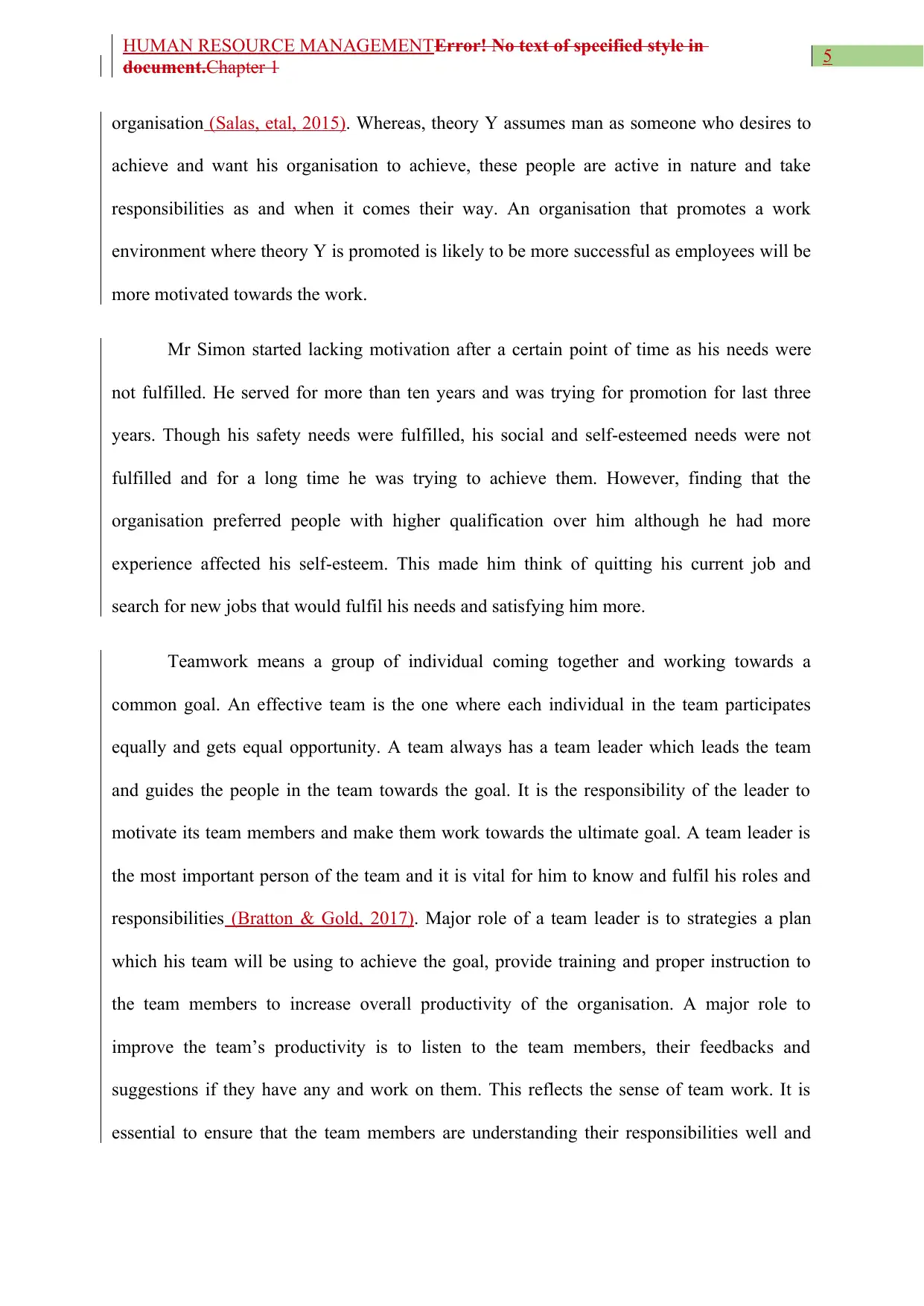
5
HUMAN RESOURCE MANAGEMENTError! No text of specified style in
document.Chapter 1
organisation (Salas, etal, 2015). Whereas, theory Y assumes man as someone who desires to
achieve and want his organisation to achieve, these people are active in nature and take
responsibilities as and when it comes their way. An organisation that promotes a work
environment where theory Y is promoted is likely to be more successful as employees will be
more motivated towards the work.
Mr Simon started lacking motivation after a certain point of time as his needs were
not fulfilled. He served for more than ten years and was trying for promotion for last three
years. Though his safety needs were fulfilled, his social and self-esteemed needs were not
fulfilled and for a long time he was trying to achieve them. However, finding that the
organisation preferred people with higher qualification over him although he had more
experience affected his self-esteem. This made him think of quitting his current job and
search for new jobs that would fulfil his needs and satisfying him more.
Teamwork means a group of individual coming together and working towards a
common goal. An effective team is the one where each individual in the team participates
equally and gets equal opportunity. A team always has a team leader which leads the team
and guides the people in the team towards the goal. It is the responsibility of the leader to
motivate its team members and make them work towards the ultimate goal. A team leader is
the most important person of the team and it is vital for him to know and fulfil his roles and
responsibilities (Bratton & Gold, 2017). Major role of a team leader is to strategies a plan
which his team will be using to achieve the goal, provide training and proper instruction to
the team members to increase overall productivity of the organisation. A major role to
improve the team’s productivity is to listen to the team members, their feedbacks and
suggestions if they have any and work on them. This reflects the sense of team work. It is
essential to ensure that the team members are understanding their responsibilities well and
HUMAN RESOURCE MANAGEMENTError! No text of specified style in
document.Chapter 1
organisation (Salas, etal, 2015). Whereas, theory Y assumes man as someone who desires to
achieve and want his organisation to achieve, these people are active in nature and take
responsibilities as and when it comes their way. An organisation that promotes a work
environment where theory Y is promoted is likely to be more successful as employees will be
more motivated towards the work.
Mr Simon started lacking motivation after a certain point of time as his needs were
not fulfilled. He served for more than ten years and was trying for promotion for last three
years. Though his safety needs were fulfilled, his social and self-esteemed needs were not
fulfilled and for a long time he was trying to achieve them. However, finding that the
organisation preferred people with higher qualification over him although he had more
experience affected his self-esteem. This made him think of quitting his current job and
search for new jobs that would fulfil his needs and satisfying him more.
Teamwork means a group of individual coming together and working towards a
common goal. An effective team is the one where each individual in the team participates
equally and gets equal opportunity. A team always has a team leader which leads the team
and guides the people in the team towards the goal. It is the responsibility of the leader to
motivate its team members and make them work towards the ultimate goal. A team leader is
the most important person of the team and it is vital for him to know and fulfil his roles and
responsibilities (Bratton & Gold, 2017). Major role of a team leader is to strategies a plan
which his team will be using to achieve the goal, provide training and proper instruction to
the team members to increase overall productivity of the organisation. A major role to
improve the team’s productivity is to listen to the team members, their feedbacks and
suggestions if they have any and work on them. This reflects the sense of team work. It is
essential to ensure that the team members are understanding their responsibilities well and
⊘ This is a preview!⊘
Do you want full access?
Subscribe today to unlock all pages.

Trusted by 1+ million students worldwide
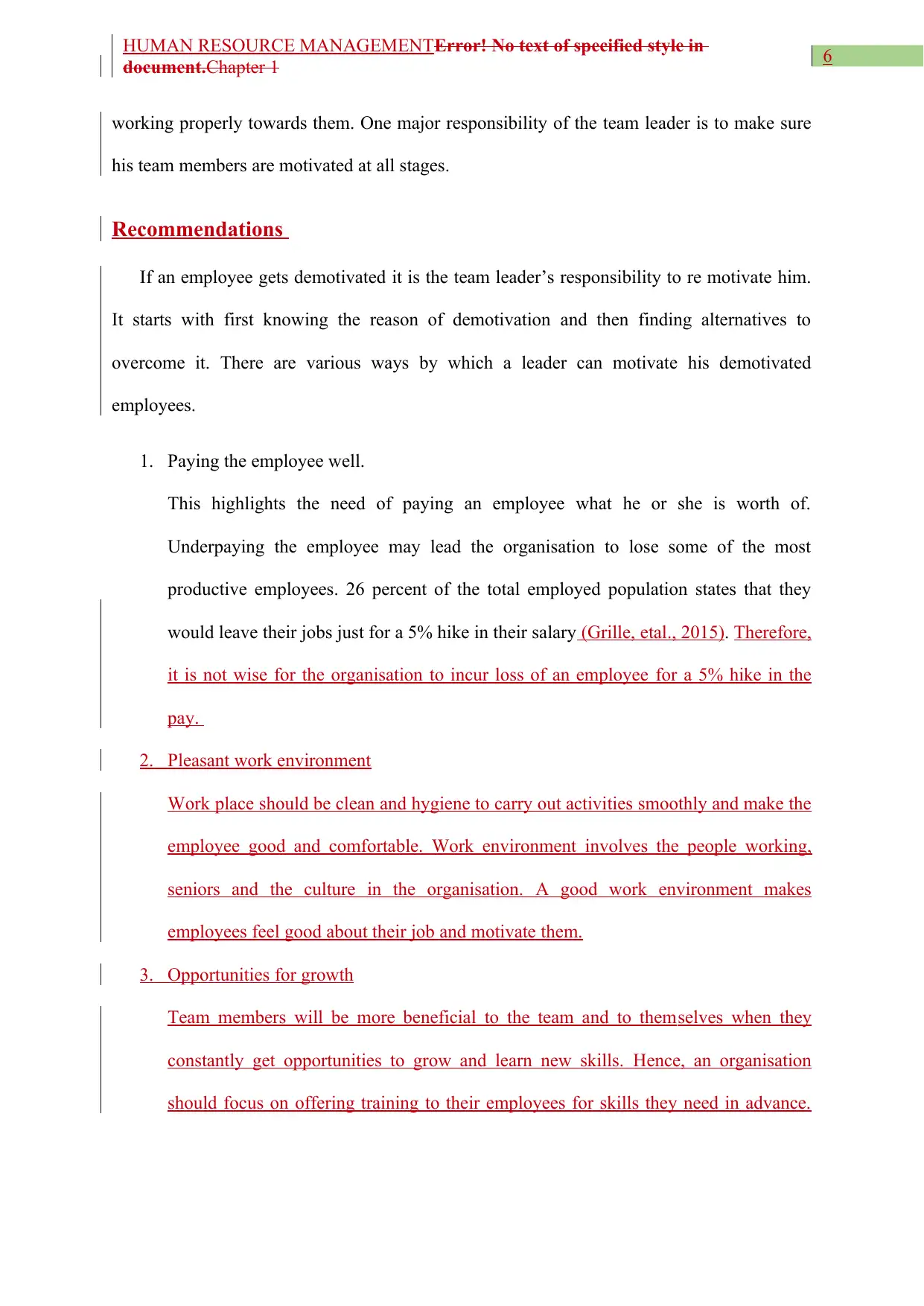
6
HUMAN RESOURCE MANAGEMENTError! No text of specified style in
document.Chapter 1
working properly towards them. One major responsibility of the team leader is to make sure
his team members are motivated at all stages.
Recommendations
If an employee gets demotivated it is the team leader’s responsibility to re motivate him.
It starts with first knowing the reason of demotivation and then finding alternatives to
overcome it. There are various ways by which a leader can motivate his demotivated
employees.
1. Paying the employee well.
This highlights the need of paying an employee what he or she is worth of.
Underpaying the employee may lead the organisation to lose some of the most
productive employees. 26 percent of the total employed population states that they
would leave their jobs just for a 5% hike in their salary (Grille, etal., 2015). Therefore,
it is not wise for the organisation to incur loss of an employee for a 5% hike in the
pay.
2. Pleasant work environment
Work place should be clean and hygiene to carry out activities smoothly and make the
employee good and comfortable. Work environment involves the people working,
seniors and the culture in the organisation. A good work environment makes
employees feel good about their job and motivate them.
3. Opportunities for growth
Team members will be more beneficial to the team and to themselves when they
constantly get opportunities to grow and learn new skills. Hence, an organisation
should focus on offering training to their employees for skills they need in advance.
HUMAN RESOURCE MANAGEMENTError! No text of specified style in
document.Chapter 1
working properly towards them. One major responsibility of the team leader is to make sure
his team members are motivated at all stages.
Recommendations
If an employee gets demotivated it is the team leader’s responsibility to re motivate him.
It starts with first knowing the reason of demotivation and then finding alternatives to
overcome it. There are various ways by which a leader can motivate his demotivated
employees.
1. Paying the employee well.
This highlights the need of paying an employee what he or she is worth of.
Underpaying the employee may lead the organisation to lose some of the most
productive employees. 26 percent of the total employed population states that they
would leave their jobs just for a 5% hike in their salary (Grille, etal., 2015). Therefore,
it is not wise for the organisation to incur loss of an employee for a 5% hike in the
pay.
2. Pleasant work environment
Work place should be clean and hygiene to carry out activities smoothly and make the
employee good and comfortable. Work environment involves the people working,
seniors and the culture in the organisation. A good work environment makes
employees feel good about their job and motivate them.
3. Opportunities for growth
Team members will be more beneficial to the team and to themselves when they
constantly get opportunities to grow and learn new skills. Hence, an organisation
should focus on offering training to their employees for skills they need in advance.
Paraphrase This Document
Need a fresh take? Get an instant paraphrase of this document with our AI Paraphraser
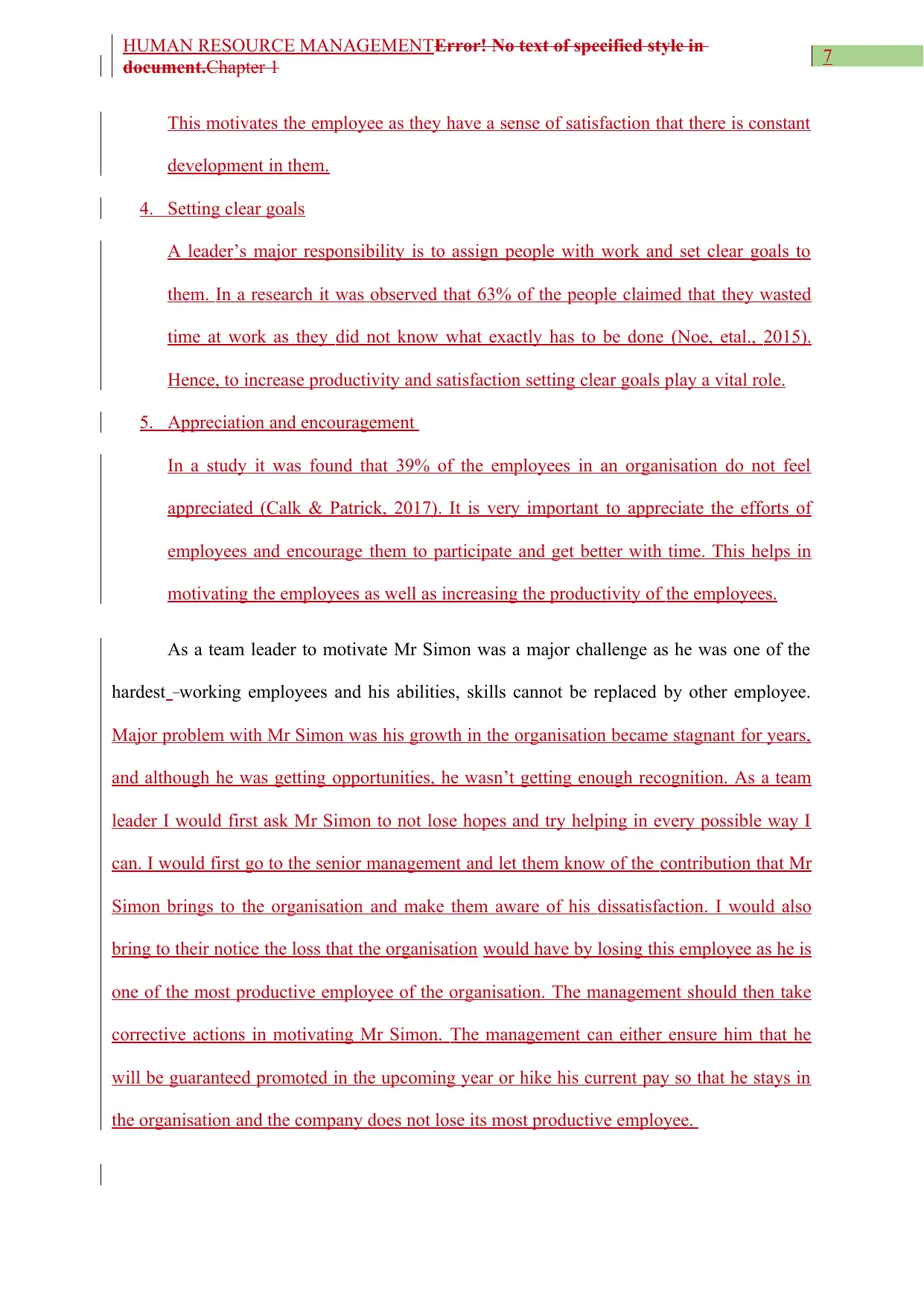
7
HUMAN RESOURCE MANAGEMENTError! No text of specified style in
document.Chapter 1
This motivates the employee as they have a sense of satisfaction that there is constant
development in them.
4. Setting clear goals
A leader’s major responsibility is to assign people with work and set clear goals to
them. In a research it was observed that 63% of the people claimed that they wasted
time at work as they did not know what exactly has to be done (Noe, etal., 2015).
Hence, to increase productivity and satisfaction setting clear goals play a vital role.
5. Appreciation and encouragement
In a study it was found that 39% of the employees in an organisation do not feel
appreciated (Calk & Patrick, 2017). It is very important to appreciate the efforts of
employees and encourage them to participate and get better with time. This helps in
motivating the employees as well as increasing the productivity of the employees.
As a team leader to motivate Mr Simon was a major challenge as he was one of the
hardest working employees and his abilities, skills cannot be replaced by other employee.
Major problem with Mr Simon was his growth in the organisation became stagnant for years,
and although he was getting opportunities, he wasn’t getting enough recognition. As a team
leader I would first ask Mr Simon to not lose hopes and try helping in every possible way I
can. I would first go to the senior management and let them know of the contribution that Mr
Simon brings to the organisation and make them aware of his dissatisfaction. I would also
bring to their notice the loss that the organisation would have by losing this employee as he is
one of the most productive employee of the organisation. The management should then take
corrective actions in motivating Mr Simon. The management can either ensure him that he
will be guaranteed promoted in the upcoming year or hike his current pay so that he stays in
the organisation and the company does not lose its most productive employee.
HUMAN RESOURCE MANAGEMENTError! No text of specified style in
document.Chapter 1
This motivates the employee as they have a sense of satisfaction that there is constant
development in them.
4. Setting clear goals
A leader’s major responsibility is to assign people with work and set clear goals to
them. In a research it was observed that 63% of the people claimed that they wasted
time at work as they did not know what exactly has to be done (Noe, etal., 2015).
Hence, to increase productivity and satisfaction setting clear goals play a vital role.
5. Appreciation and encouragement
In a study it was found that 39% of the employees in an organisation do not feel
appreciated (Calk & Patrick, 2017). It is very important to appreciate the efforts of
employees and encourage them to participate and get better with time. This helps in
motivating the employees as well as increasing the productivity of the employees.
As a team leader to motivate Mr Simon was a major challenge as he was one of the
hardest working employees and his abilities, skills cannot be replaced by other employee.
Major problem with Mr Simon was his growth in the organisation became stagnant for years,
and although he was getting opportunities, he wasn’t getting enough recognition. As a team
leader I would first ask Mr Simon to not lose hopes and try helping in every possible way I
can. I would first go to the senior management and let them know of the contribution that Mr
Simon brings to the organisation and make them aware of his dissatisfaction. I would also
bring to their notice the loss that the organisation would have by losing this employee as he is
one of the most productive employee of the organisation. The management should then take
corrective actions in motivating Mr Simon. The management can either ensure him that he
will be guaranteed promoted in the upcoming year or hike his current pay so that he stays in
the organisation and the company does not lose its most productive employee.
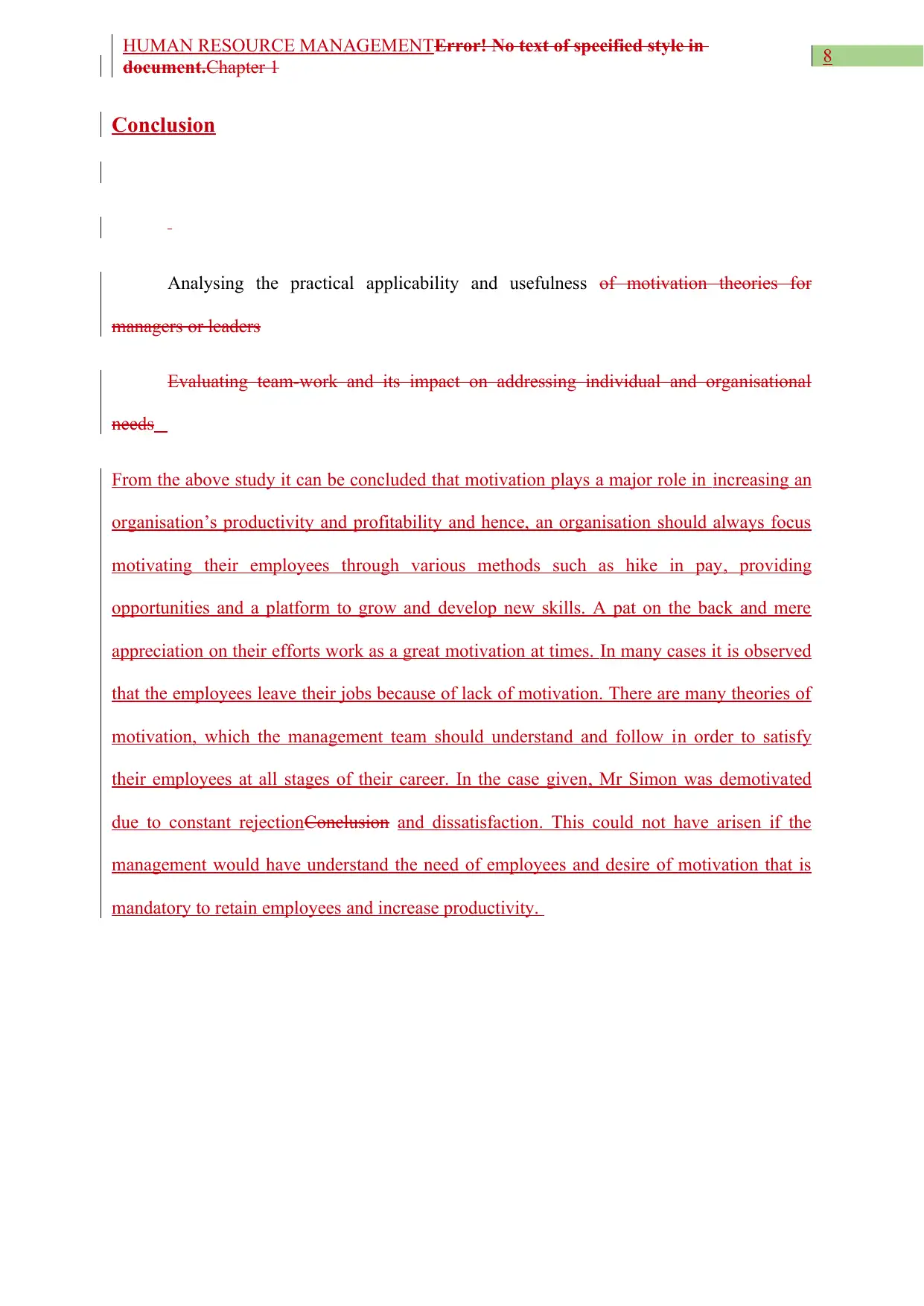
8
HUMAN RESOURCE MANAGEMENTError! No text of specified style in
document.Chapter 1
Conclusion
Analysing the practical applicability and usefulness of motivation theories for
managers or leaders
Evaluating team-work and its impact on addressing individual and organisational
needs
From the above study it can be concluded that motivation plays a major role in increasing an
organisation’s productivity and profitability and hence, an organisation should always focus
motivating their employees through various methods such as hike in pay, providing
opportunities and a platform to grow and develop new skills. A pat on the back and mere
appreciation on their efforts work as a great motivation at times. In many cases it is observed
that the employees leave their jobs because of lack of motivation. There are many theories of
motivation, which the management team should understand and follow in order to satisfy
their employees at all stages of their career. In the case given, Mr Simon was demotivated
due to constant rejectionConclusion and dissatisfaction. This could not have arisen if the
management would have understand the need of employees and desire of motivation that is
mandatory to retain employees and increase productivity.
HUMAN RESOURCE MANAGEMENTError! No text of specified style in
document.Chapter 1
Conclusion
Analysing the practical applicability and usefulness of motivation theories for
managers or leaders
Evaluating team-work and its impact on addressing individual and organisational
needs
From the above study it can be concluded that motivation plays a major role in increasing an
organisation’s productivity and profitability and hence, an organisation should always focus
motivating their employees through various methods such as hike in pay, providing
opportunities and a platform to grow and develop new skills. A pat on the back and mere
appreciation on their efforts work as a great motivation at times. In many cases it is observed
that the employees leave their jobs because of lack of motivation. There are many theories of
motivation, which the management team should understand and follow in order to satisfy
their employees at all stages of their career. In the case given, Mr Simon was demotivated
due to constant rejectionConclusion and dissatisfaction. This could not have arisen if the
management would have understand the need of employees and desire of motivation that is
mandatory to retain employees and increase productivity.
⊘ This is a preview!⊘
Do you want full access?
Subscribe today to unlock all pages.

Trusted by 1+ million students worldwide
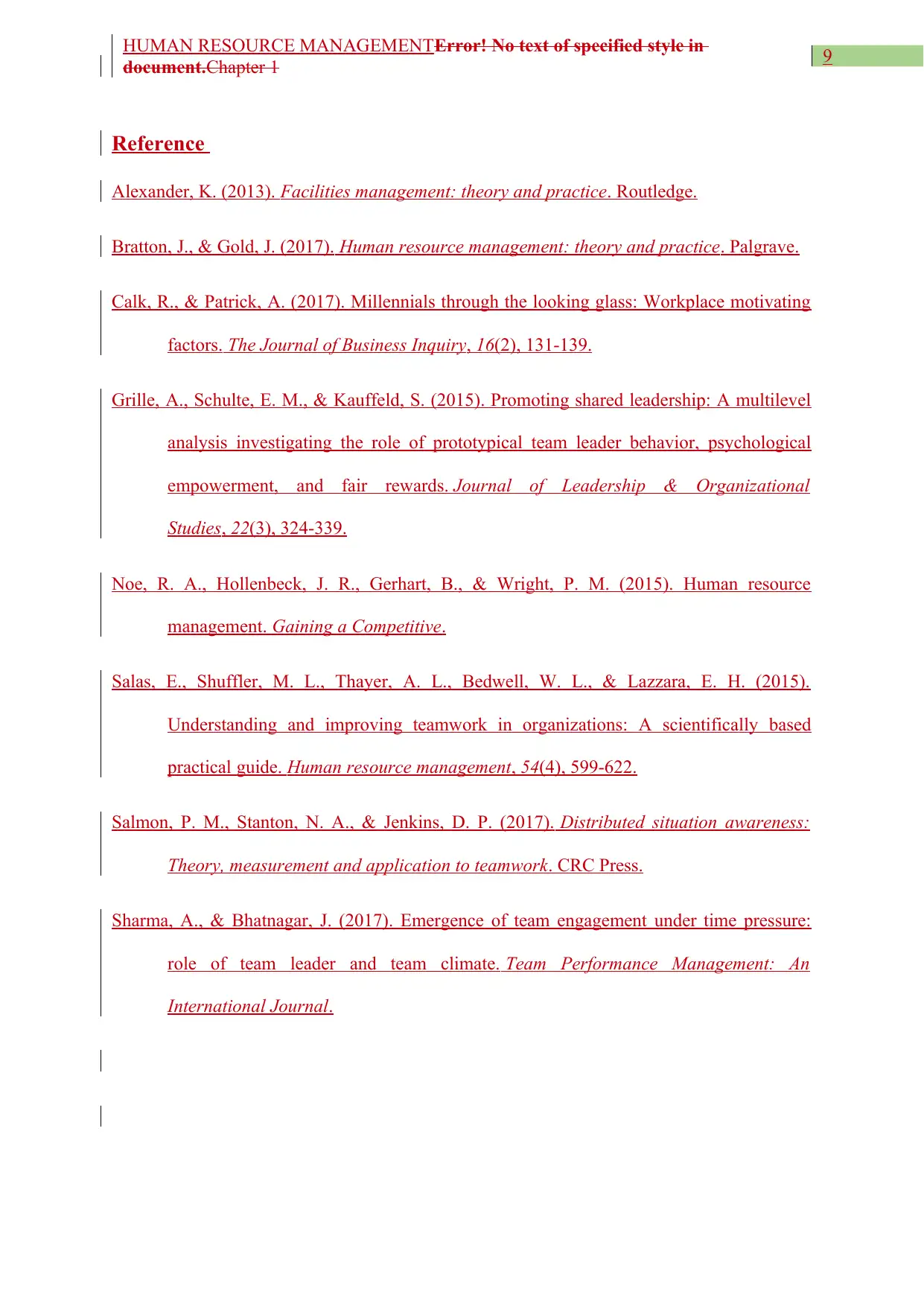
9
HUMAN RESOURCE MANAGEMENTError! No text of specified style in
document.Chapter 1
Reference
Alexander, K. (2013). Facilities management: theory and practice. Routledge.
Bratton, J., & Gold, J. (2017). Human resource management: theory and practice. Palgrave.
Calk, R., & Patrick, A. (2017). Millennials through the looking glass: Workplace motivating
factors. The Journal of Business Inquiry, 16(2), 131-139.
Grille, A., Schulte, E. M., & Kauffeld, S. (2015). Promoting shared leadership: A multilevel
analysis investigating the role of prototypical team leader behavior, psychological
empowerment, and fair rewards. Journal of Leadership & Organizational
Studies, 22(3), 324-339.
Noe, R. A., Hollenbeck, J. R., Gerhart, B., & Wright, P. M. (2015). Human resource
management. Gaining a Competitive.
Salas, E., Shuffler, M. L., Thayer, A. L., Bedwell, W. L., & Lazzara, E. H. (2015).
Understanding and improving teamwork in organizations: A scientifically based
practical guide. Human resource management, 54(4), 599-622.
Salmon, P. M., Stanton, N. A., & Jenkins, D. P. (2017). Distributed situation awareness:
Theory, measurement and application to teamwork. CRC Press.
Sharma, A., & Bhatnagar, J. (2017). Emergence of team engagement under time pressure:
role of team leader and team climate. Team Performance Management: An
International Journal.
HUMAN RESOURCE MANAGEMENTError! No text of specified style in
document.Chapter 1
Reference
Alexander, K. (2013). Facilities management: theory and practice. Routledge.
Bratton, J., & Gold, J. (2017). Human resource management: theory and practice. Palgrave.
Calk, R., & Patrick, A. (2017). Millennials through the looking glass: Workplace motivating
factors. The Journal of Business Inquiry, 16(2), 131-139.
Grille, A., Schulte, E. M., & Kauffeld, S. (2015). Promoting shared leadership: A multilevel
analysis investigating the role of prototypical team leader behavior, psychological
empowerment, and fair rewards. Journal of Leadership & Organizational
Studies, 22(3), 324-339.
Noe, R. A., Hollenbeck, J. R., Gerhart, B., & Wright, P. M. (2015). Human resource
management. Gaining a Competitive.
Salas, E., Shuffler, M. L., Thayer, A. L., Bedwell, W. L., & Lazzara, E. H. (2015).
Understanding and improving teamwork in organizations: A scientifically based
practical guide. Human resource management, 54(4), 599-622.
Salmon, P. M., Stanton, N. A., & Jenkins, D. P. (2017). Distributed situation awareness:
Theory, measurement and application to teamwork. CRC Press.
Sharma, A., & Bhatnagar, J. (2017). Emergence of team engagement under time pressure:
role of team leader and team climate. Team Performance Management: An
International Journal.
1 out of 10
Related Documents
Your All-in-One AI-Powered Toolkit for Academic Success.
+13062052269
info@desklib.com
Available 24*7 on WhatsApp / Email
![[object Object]](/_next/static/media/star-bottom.7253800d.svg)
Unlock your academic potential
Copyright © 2020–2025 A2Z Services. All Rights Reserved. Developed and managed by ZUCOL.





